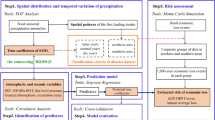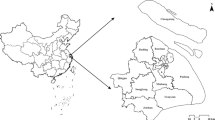Abstract
Assessing the response of flood risk caused by climate change and social development is very important in terms of determining high risk areas in different periods as well as making disaster mitigating plans. We establish a flood risk assessment model based on geographic information system and natural disaster risk assessment theory. In order to compare the index value in different periods and spaces, we utilize the spatial and temporal standardization method to standardized index. To avoid one-sidedness caused by using one weight calibration method only, we employ the least square method to synthesize weights determine by the Analytic Hierarchy Process (AHP) method and the Entropy weight method. We adopt the observed data of the Huaihe River basin from 1960 to 2010 to assess the changing of flood risk between period I (1960–1980) and period II (1980–2010). After pre-processing the atmosphere–ocean coupled global circulation models (AOGCM) data, including bias correction and downscaling, we use the corrected data to predict the flood risk during future period III (2010–2040). The results show that high risk areas and moderate to high risk areas during period I take up 17.68 and 33.88 % of the total area of the Huaihe River basin, respectively. During period II, the high risk areas show an increasing percent change of 1.93 % and a decreasing trend in moderate to high risk areas of 3.8 %. Compared with period II, the high risk areas and the moderate to high risk areas during period III show an increasing trend of 8.02 and 0.77 %, which is the result of the combined effects of climate change and social development. The results presented here can provide useful information for decision-makers.










Similar content being viewed by others
References
Bouwer LM, Bubeck P, Aerts JCJH (2010) Changes in future flood risk due to climate and development in a Dutch polder area. Global Environ Chang 20:463–471. doi:10.1016/j.gloenvcha.2010.04.002
Bowering EA, Peck AM, Simonovic SP (2014) A flood risk assessment to municipal infrastructure due to changing climate part I: methodology. Urban Water J 11:20–30. doi:10.1080/1573062X.2012.758293
Chen JF, Liu GY, Wang HM, Li M, Liu GF (2012) Research on flood risk zoning based on information diffusion and entropy theory in the Huaihe River Basin, China. Disaster Adv 5:1224–1230
Chen T, Jin YY, Qiu XP, Chen X (2014) A hybrid fuzzy evaluation method for safety assessment of food-waste feed based on entropy and the analytic hierarchy process methods. Expert Syst Appl 41:7328–7337. doi:10.1016/j.eswa.2014.06.006
Dankers R, Feyen L (2008) Climate change impact on flood hazard in Europe: an assessment based on high-resolution climate simulations. J Geophys Res-Atmos. doi:10.1029/2007jd009719
Eichengreen B, Park D, Shin K (2011) When fast growing economies slow down: international evidence and implications for China. Natl Bureau Econ Res. doi:10.3386/w16919
Eum HI, Sredojevic D, Simonovic SP (2011) Engineering procedure for the climate change flood risk assessment in the Upper Thames River Basin. J Hydrol Eng 16:608–612. doi:10.1061/(Asce)He.1943-5584.0000346
Field CB et al. (2014) IPCC, 2014: Summary for policymakers. In: Climate Change 2014: impacts, adaptation, and vulnerability. Part A: global and sectoral aspects. Contribution of Working Group II to the Fifth Assessment Report of the Intergovernmental Panel on Climate Change, vol 12. Cambridge University Press, Cambridge, United Kingdom and New York, NY, USA, pp 1–32
Fogel RW (2007) Capitalism and Democracy in 2040: forecasts and Speculations. Natl Bureau Econ Res. doi:10.3386/w13184
Gao C, Zhang Z, Zhai J, Qing L, Mengting Y (2015) Research on meteorological thresholds of drought and flood disaster: a case study in the Huai River Basin, China. Stoch Environ Res Risk Assess 29:157–167. doi:10.1007/s00477-014-0951-y
Hajkowicz S, Collins K (2007) A review of multiple criteria analysis for water resource planning and management. Water Resour Manag 21:1553–1566. doi:10.1007/s11269-006-9112-5
Hirabayashi Y et al (2013) Global flood risk under climate change. Nat Clim Change 3:816–821. doi:10.1038/Nclimate1911
IPCC (2013) Climate change 2013: The physical science basis. Contribution of Working Group I to the Fifth Assessment Report of the Intergovernmental Panel on Climate Change. Cambridge University Press, Cambridge, United Kingdom and New York, NY, USA. doi:10.1017/cbo9781107415324
Jenks GF (1967) The data model concept in statistical mapping. Int Yearbook Cartogr 7:186–190
Ji ZH, Li N, Xie W, Wu JD, Zhou Y (2013) Comprehensive assessment of flood risk using the classification and regression tree method. Stoch Environ Res Risk Assess 27:1815–1828. doi:10.1007/s00477-013-0716-z
Li XG, Wei X, Huang Q (2012) Comprehensive entropy weight observability-controllability risk analysis and its application to water resource decision-making. Water SA 38:573–579. doi:10.4314/wsa.v38i4.13
Ling H (2011) Analyses on Space-time Change Features of Rainstorm and Risk Assessment over Huai River Basin. Dissertation, Nanjing University of Information Science & Technology
Lu ZG, Zhang XH, Huo Jl, Wang KQ, Xie XP (2011) The evolution characteristics of the extreme precipitation in Huaihe river basin during 1960–1980. J Meteorol Sci:77–83 (in Chinese)
Maskrey A (1989) Disaster mitigation: a community based approach, vol 3. Oxfam, Oxford
Meyer V, Scheuer S, Haase D (2009) A multicriteria approach for flood risk mapping exemplified at the Mulde river, Germany. Nat Hazards 48:17–39. doi:10.1007/s11069-008-9244-4
Morita M (2011) Quantification of increased flood risk due to global climate change for urban river management planning. Water Sci Technol 63:2967–2974. doi:10.2166/wst.2011.172
Ranger N et al (2011) An assessment of the potential impact of climate change on flood risk in Mumbai. Clim Change 104:139–167. doi:10.1007/s10584-010-9979-2
Saaty TL (1988) What is the analytic hierarchy process? Mathematical models for decision support. Springer, Berlin
Sarwar R, Irwin SE, King LM, Simonovic SP (2012) Assessment of climatic vulnerability in the Upper Thames River basin: Downscaling with SDSM. The University of Western Ontario Department of Civil and Environmental Engineering
Stefanidis S, Stathis D (2013) Assessment of flood hazard based on natural and anthropogenic factors using analytic hierarchy process (AHP). Nat Hazards 68:569–585. doi:10.1007/s11069-013-0639-5
Van Dyck J, Willems P (2013) Probabilistic flood risk assessment over large geographical regions. Water Resour Res 49:3330–3344. doi:10.1002/wrcr.20149
Wang YM, Li ZW, Tang ZH, Zeng GM (2011) A GIS-based spatial multi-criteria approach for flood risk assessment in the Dongting Lake Region, Hunan, Central China. Water Resour Manag 25:3465–3484. doi:10.1007/s11269-011-9866-2
Wang T, J-s Chen, Wang T, Wang S (2015a) Entropy weight-set pair analysis based on tracer techniques for dam leakage investigation. Nat Hazards 76:747–767. doi:10.1007/s11069-014-1515-7
Wang WG, Wei JD, Shao QX, Xing WQ, Yong B, Yu ZB, Jiao XY (2015b) Spatial and temporal variations in hydro-climatic variables and runoff in response to climate change in the Luanhe River basin, China. Stoch Environ Res Risk Assess 29:1117–1133. doi:10.1007/s00477-014-1003-3
Wu Y, P-a Zhong, Zhang Y, Xu B, Ma B, Yan K (2015) Integrated flood risk assessment and zonation method: a case study in Huaihe River basin, China. Nat Hazards 78:635–651. doi:10.1007/s11069-015-1737-3
Xing WQ, Wang WG, Wu YQ, An GY (2011) Change properties of precipitation concentration in Huaihe River basin. Water Resour Power 29:1–5 (in Chinese)
Xu S, Wang T, Hu S (2015) Dynamic assessment of water quality based on a variable fuzzy pattern recognition model. Int J Environ Res Public Health 12:2230–2248. doi:10.3390/ijerph120202230
Yang Z (2008) Study on relationship between population and economic spatial distribution in China. Dissertation, Lanzhou University
Yang MM, Zhong PA, Wei P (2012) Study on precipitation evolution rule of Huaihe River basin in main flood period. Water Resources and Power:37–40 (in Chinese)
Yoon SK, Kim JS, Moon YI (2014) Integrated flood risk analysis in a changing climate: a case study from the Korean Han River Basin. KSCE J Civ Eng 18:1563–1571. doi:10.1007/s12205-014-0147-5
Zhang YL, You WJ (2014) Social vulnerability to floods: a case study of Huaihe River Basin. Nat Hazards 71:2113–2125. doi:10.1007/s11069-013-0996-0
Zhao SS, He WP (2015) Performance evaluation of the simulated daily average temperature series in four seasons in China by Beijing Climate Center climate system model. Acta Phys Sin-Ch Ed. doi:10.7498/Aps.64.049201
Zhou HC, Zhang GH, Wang GL (2007) Multi-objective decision making approach based on entropy weights for reservoir flood control operation. J Hydrol Eng 38:100–106 (in Chinese)
Zhou Q, Mikkelsen PS, Halsnaes K, Arnbjerg-Nielsen K (2012) Framework for economic pluvial flood risk assessment considering climate change effects and adaptation benefits. J Hydrol 414:539–549. doi:10.1016/j.jhydrol.2011.11.031
Zou Q, Zhou JZ, Zhou C, Song LX, Guo J (2013) Comprehensive flood risk assessment based on set pair analysis-variable fuzzy sets model and fuzzy AHP. Stoch Environ Res Risk Assess 27:525–546. doi:10.1007/s00477-012-0598-5
Acknowledgments
This study is supported by the National Natural Science Foundation of China (Grant No. 51179044), the National Basic Research Program of China (973 Program, Grant No. 2010CB951102), and the Special Fund for Public Welfare Industry of the Ministry of Water Resources of China (Grant No. 201501007.
Author information
Authors and Affiliations
Corresponding author
Rights and permissions
About this article
Cite this article
Wu, Y., Zhong, Pa., Xu, B. et al. Changing of flood risk due to climate and development in Huaihe River basin, China. Stoch Environ Res Risk Assess 31, 935–948 (2017). https://doi.org/10.1007/s00477-016-1262-2
Published:
Issue Date:
DOI: https://doi.org/10.1007/s00477-016-1262-2




